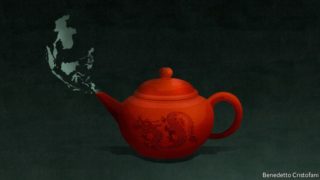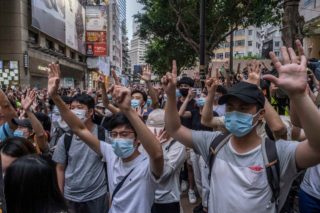Its rulings on a rush of deceptively low-profile cases could prove decisive—and divisive
TWENTY YEARS after Bush v Gore, the Supreme Court is again poised to influence a presidential election. Whether this involves the drama of another clinching verdict after a close result is to be seen. But the nine justices are already shaping the race through small decisions on voting rules, reached without a hearing and often with little written explanation.
Litigation over voting always increases before elections, but 2020 is setting records. The rival campaigns are funding a raft of lawsuits, including at least 226 related to the pandemic across 43 states, Puerto Rico and the District of Columbia. Most involve Democratic moves to expand voting opportunities or Republican efforts to quash them (wider access to the ballot typically helps Democrats). In Pennsylvania, for instance, the Democratic governor and Republican legislature are locked in a battle over how to handle an expected deluge of ballots sent by mail. The Trump campaign is suing there, as well as in Nevada and New Jersey. Mr Trump claims, with little evidence, that these states’ plans to expand postal balloting—including the use of drop boxes—invite voter fraud.
In the Nevada case, his lawyers also oppose an increase in the number of polling stations in more populous counties. They say this violates a principle in Bush v Gore—the 5-4 decision halting a recount in Florida—that requires states to provide “uniform treatment” for all voters. But by its own lights, Bush v Gore was “limited to the present circumstances” of the 2000 election since the duty of treating voters even-handedly “presents many complexities”.
Many of this year’s voting quarrels are bound to end up at the Supreme Court, where the conservative majority has shown little interest in expanding voter participation. In Republican National Committee v Democratic National Committee, the justices split 5-4 in April on whether to make absentee voting easier in the Wisconsin primary. The coronavirus had prompted many Wisconsinites to opt to vote by mail, but as many as 12,000 ballots had not yet reached their mailboxes on the eve of election day. A lower court said that, given the circumstances, absentee ballots could be counted as long as they arrived at counting stations no more than six days later. But the Supreme Court blocked that fix; it said changing the rules so close to an election would inspire “judicially created confusion”. Justice Ruth Bader Ginsburg was unimpressed. “It boggles the mind”, she wrote in her dissent, that the court would risk “massive disenfranchisement” by treating voting during a pandemic as no different from “an ordinary election”.
In July Justice Sonia Sotomayor criticised the majority for blocking pandemic-related tweaks to ballot-initiative signature collection in Idaho. And in another dissent, she excoriated the majority for allowing Florida to bar from the polls as many as 1m felons who had completed their sentences and thus—under a state constitutional amendment in 2018—had the right to vote. By ratifying a “pay-to-vote scheme” under which ex-offenders must pay all fines before punching a ballot, she wrote, the Supreme Court “continues a trend of condoning disfranchisement.”
When lower courts seek to make voting easier, Republicans often find a friendly majority on the Supreme Court to block the relief. An exception came on August 13th, when the court honoured a suspension of a two-witness requirement for absentee ballots in Rhode Island. This order seemed to conflict with its decision in July to bar such an arrangement in Alabama. But whereas Alabama had complained that a lower court’s decision ordering the suspension had rewritten its election law and barred it from “enforcing modest anti-fraud requirements”, no Rhode Island official objected.
Three justices—Samuel Alito, Neil Gorsuch and Clarence Thomas—said they would have sided with the Republicans challenging Rhode Island’s loosened rules, but more seemed to believe that such arrangements are acceptable if the state is on board. Dale Ho, director of the voting-rights project at the American Civil Liberties Union, an advocacy group, worries that voters may not be served well in some battleground states if the Supreme Court simply defers to state governments. Republican legislatures in Michigan and Wisconsin “will not compromise”, he notes, so litigation to enhance voting rights there may end in disappointment once the Supreme Court has its say.
The rush of election questions is making its way to America’s highest court in an unfortunate context. They are packaged not as slow-moving petitions on the ordinary docket but as emergency applications on a so-called “shadow docket” where justices hand down edicts with little or no explanation after only partial briefing, no live hearing and quick deliberation. Justices may also choose to stay mum: they reveal their votes only if they so choose. Many requests for last-ditch execution stays and other emergency matters come before the court in this manner each year. But when it comes to decisions shaping an election, the opacity is “really problematic”, Mr Ho worries. “They need to explain their reasoning more”, he says, to guide lower courts and the next round of litigants.
The lawsuits keep coming. A cunning Republican suit to keep Green candidates on the ballot in Montana to draw votes from Democrats reached the Supreme Court last week and was promptly rejected. Challenges involving the United States Postal Service are just getting under way in lower courts. With a rash of voting disputes destined for the justices’ inbox, the spectre remains of another presidential election decided by nine unelected jurists. Rick Pildes, a law professor at New York University, says the justices should strive for “significant consensus” in issuing decisions on voting rules if the election results are to be “broadly accepted as legitimate”. But in light of how the cases have been adjudicated thus far—five of six were split votes, some with barbed exchanges—judicial rulings shaping the outcome on November 3rd may prove to be as divisive as the vote itself.
By The Economist





